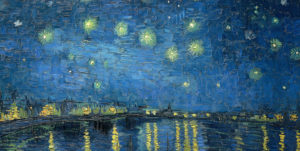Hildegard
‘…the ‘whole-making spirit.’
March 17, 2018☆The life pouring through us, pumping our heart and breathing through our lungs, did not begin at our birth or conception. Like every particle in every atom and molecule of our bodies, it goes back through time to the first splitting and spinning of the stars. —Joanna Macy
☆Our inner spiritual world cannot be activated without experience of the outer world of wonder for the mind, beauty for the imagination, and intimacy for the emotions. —Thomas Berry
Viriditas
Richard Rohr:
Long ago, St. Hildegard of Bingen (1098-1179), named a Doctor of the Church in 2012, communicated creation spirituality through music, art, poetry, medicine, gardening, and reflections on nature. She wrote in her famous book, Scivias:
You understand so little of what is around you because you do not use what is within you.
This is key to understanding Hildegard and is very similar to Teresa of Ávila’s understanding of the soul. Without using the word, Hildegard recognized that the human person is a microcosm with a natural affinity for or resonance with its macrocosm, which many call God. Our little world reflects the big world. The key word here is resonance. Contemplative prayer allows your mind to resonate with what is visible and right in front of you. Contemplation erases the separateness between the seer and the seen.
Hildegard often used the word viriditas, the greening of things from within, similar to what we now call photosynthesis. She recognized a readiness in plants to receive the sun and to transform it into energy and life. She also saw an inherent connection between the physical world and the divine Presence. This connection translates into energy that is the soul and seed of everything, an inner voice calling you to “Become who you are; become all that you are.” This is our “life wish” or what Carl Jung called the “whole-making spirit.”
Hildegard is a wonderful example of someone who lives safely inside an entire cosmology, a universe where the inner shows itself in the outer, and the outer reflects the inner, where the individual reflects the cosmos, and the cosmos reflects the individual. Hildegard said, “O Holy Spirit, you are the mighty way in which every thing that is in the heavens, on the earth, and under the earth, is penetrated with connectedness, penetrated with relatedness.” [2] It is truly a Trinitarian universe, with all things whirling toward one another: from orbits, to gravity, to ecosystems, to sexuality.
Indeed, for Hildegard nature was a mirror for the soul and for God. This mirroring changes how we see and experience reality. Later, Bonaventure (1217-1274) wrote: “In the soul’s journey to God we must present to ourselves the whole material world as the first mirror through which we may pass over to the Supreme. “ The Dominican Meister Eckhart (1260-1327) said the same: “If humankind could have known God without the world, God would never have created the world.” [5]
Nature is not a mere scenic backdrop so humans can take over the stage. Creation is in fact a full participant in human transformation, since the outer world is absolutely needed to mirror the true inner world. There are not just two sacraments, or even seven; the whole world is a sacrament.
[Meister Eckhart, The Complete Mystical Works of Meister Eckhart, ed. Maurice O’Connell Walshe, rev. Bernard McGinn (New York: The Crossroad Publishing Company, 2009), 275.]
When we look down on the Earth from space, we see this amazing, indescribably beautiful planet. It looks like a living, breathing organism. But it also at the same time, looks extremely fragile.—Ron Garan, NASA Astronaut
I have set before you life and death, therefore choose life. —Deuteronomy 30:19
